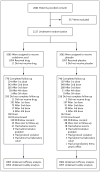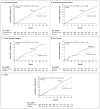Zoledronic acid and clinical fractures and mortality after hip fracture
- PMID: 17878149
- PMCID: PMC2324066
- DOI: 10.1056/NEJMoa074941
Zoledronic acid and clinical fractures and mortality after hip fracture
Abstract
Background: Mortality is increased after a hip fracture, and strategies that improve outcomes are needed.
Methods: In this randomized, double-blind, placebo-controlled trial, 1065 patients were assigned to receive yearly intravenous zoledronic acid (at a dose of 5 mg), and 1062 patients were assigned to receive placebo. The infusions were first administered within 90 days after surgical repair of a hip fracture. All patients (mean age, 74.5 years) received supplemental vitamin D and calcium. The median follow-up was 1.9 years. The primary end point was a new clinical fracture.
Results: The rates of any new clinical fracture were 8.6% in the zoledronic acid group and 13.9% in the placebo group, a 35% risk reduction with zoledronic acid (P=0.001); the respective rates of a new clinical vertebral fracture were 1.7% and 3.8% (P=0.02), and the respective rates of new nonvertebral fractures were 7.6% and 10.7% (P=0.03). In the safety analysis, 101 of 1054 patients in the zoledronic acid group (9.6%) and 141 of 1057 patients in the placebo group (13.3%) died, a reduction of 28% in deaths from any cause in the zoledronic acid group (P=0.01). The most frequent adverse events in patients receiving zoledronic acid were pyrexia, myalgia, and bone and musculoskeletal pain. No cases of osteonecrosis of the jaw were reported, and no adverse effects on the healing of fractures were noted. The rates of renal and cardiovascular adverse events, including atrial fibrillation and stroke, were similar in the two groups.
Conclusions: An annual infusion of zoledronic acid within 90 days after repair of a low-trauma hip fracture was associated with a reduction in the rate of new clinical fractures and with improved survival. (ClinicalTrials.gov number, NCT00046254 [ClinicalTrials.gov].).
Copyright 2007 Massachusetts Medical Society.
Figures
Comment in
-
Zoledronic acid and secondary prevention of fractures.N Engl J Med. 2007 Nov 1;357(18):1861-2. doi: 10.1056/NEJMe078192. Epub 2007 Sep 17. N Engl J Med. 2007. PMID: 17878150 No abstract available.
-
Annual zoledronic acid infusion lowers risk of fracture, death.J Fam Pract. 2007 Dec;56(12):1013-6. J Fam Pract. 2007. PMID: 18053440 Free PMC article. No abstract available.
-
Zoledronate, fractures, and mortality after hip fracture.N Engl J Med. 2008 Feb 28;358(9):967; author reply 968-9. doi: 10.1056/NEJMc073292. N Engl J Med. 2008. PMID: 18305273 No abstract available.
-
Intravenous zoledronic acid reduced new clinical fractures and deaths in patients who had recent surgery for hip fracture.ACP J Club. 2008 Mar-Apr;148(2):40. ACP J Club. 2008. PMID: 18311870 No abstract available.
-
New horizons for zoledronic acid: results of the HORIZON trials in postmenopausal women with osteoporosis and after hip fracture.Expert Opin Pharmacother. 2008 Mar;9(4):663-8. doi: 10.1517/14656566.9.4.663. Expert Opin Pharmacother. 2008. PMID: 18312167 No abstract available.
-
Zoledronate, fractures, and mortality after hip fracture.N Engl J Med. 2008 Feb 28;358(9):969; author reply 968-9. N Engl J Med. 2008. PMID: 18314545 No abstract available.
-
Zoledronate, fractures, and mortality after hip fracture.N Engl J Med. 2008 Feb 28;358(9):967-8; author reply 968-9. N Engl J Med. 2008. PMID: 18314546 No abstract available.
-
Once-yearly zoledronate-an effective preventative therapy for new fractures after hip fracture?Nat Clin Pract Endocrinol Metab. 2008 Jun;4(6):308-9. doi: 10.1038/ncpendmet0813. Epub 2008 Apr 8. Nat Clin Pract Endocrinol Metab. 2008. PMID: 18398403 No abstract available.
References
-
- Boonen S, Autier P, Barette M, Vanderschueren D, Lips P, Haentjens P. Functional outcome and quality of life following hip fracture in elderly women: a one-year prospective controlled study. Osteoporos Int. 2004;15:87–94. - PubMed
-
- Magaziner J, Hawkes W, Hebel JR, et al. Recovery from hip fracture in eight areas of function. J Gerontol A Biol Sci Med Sci. 2000;55:M498–M507. - PubMed
-
- Adachi JD, Ioannidis G, Berger C, et al. The influence of osteoporotic fractures on health related quality of life in community-dwelling men and women across Canada. Osteoporos Int. 2001;12:903–8. - PubMed
-
- Hannan EL, Magaziner J, Wang JJ, et al. Mortality and locomotion 6 months after hospitalization for hip fracture: risk factors and risk-adjusted hospital outcomes. JAMA. 2001;285:2736–42. - PubMed
Publication types
MeSH terms
Substances
Associated data
Grants and funding
LinkOut - more resources
Full Text Sources
Other Literature Sources
Medical


